BAO3309 - Advanced Financial Accounting: Integrated Reporting
VerifiedAdded on 2022/08/25
|15
|4490
|22
Report
AI Summary
This report provides an in-depth analysis of integrated reporting, focusing on the role of the International Integrated Reporting Committee (IIRC) and the findings of a CPA Australia report on stakeholder information needs. The report examines the IIRC's function in promoting integrated reporting and its framework. It then analyzes the CPA report's exploration of stakeholder expectations, the alignment of these expectations, and the usefulness of integrated reporting for decision-making. The report covers various aspects of integrated reporting, including stakeholder relationships, materiality, conciseness, reliability, consistency, and comparability. It identifies similarities and differences between the integrated reporting framework, the use of general-purpose financial reports, and the concept of materiality. Finally, the report compares and contrasts the integrated reports of four companies (ABSA, ABN AMARO, ACCA, and ACHMEA), highlighting differences in their approaches and disclosures.
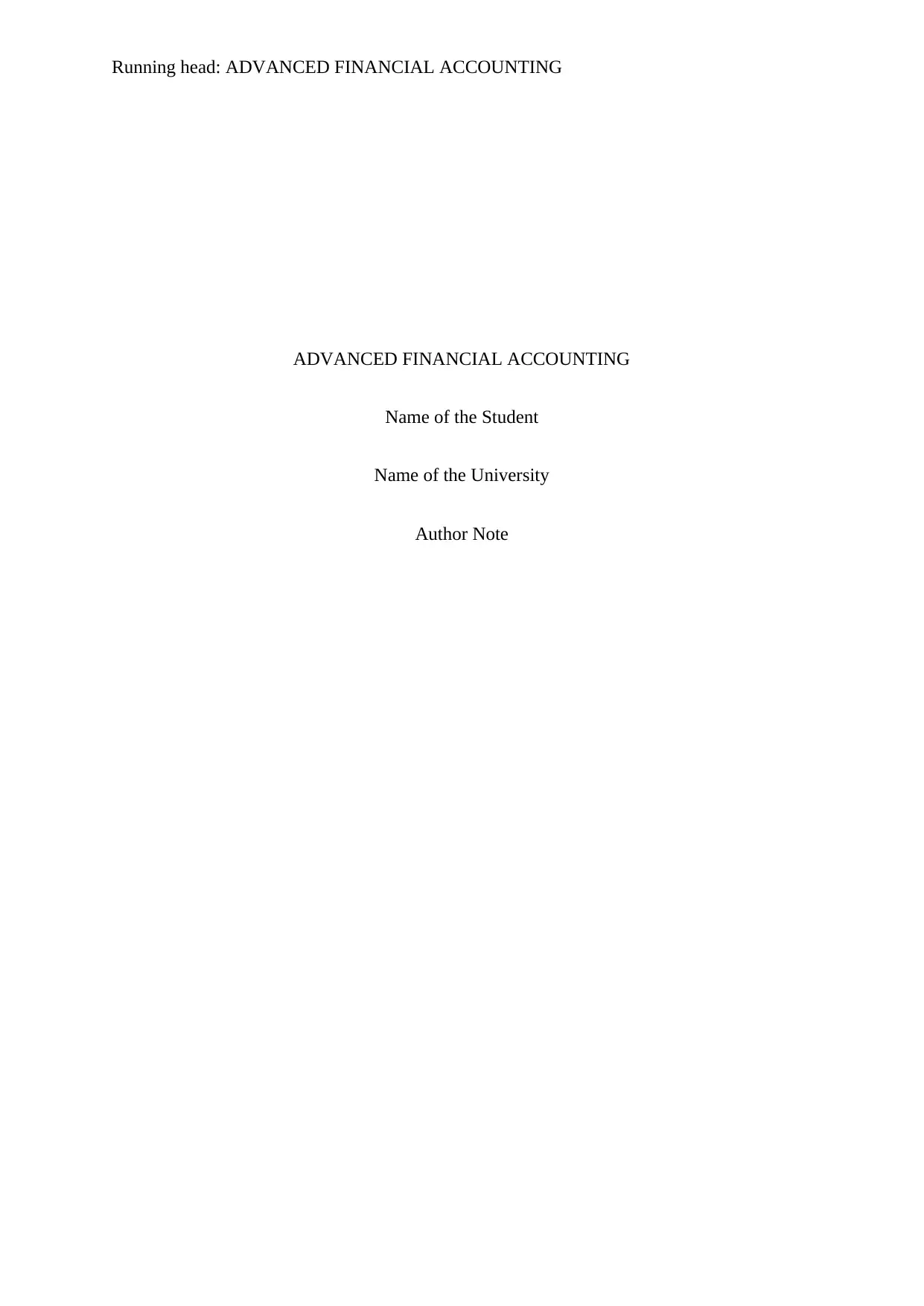
Running head: ADVANCED FINANCIAL ACCOUNTING
ADVANCED FINANCIAL ACCOUNTING
Name of the Student
Name of the University
Author Note
ADVANCED FINANCIAL ACCOUNTING
Name of the Student
Name of the University
Author Note
Paraphrase This Document
Need a fresh take? Get an instant paraphrase of this document with our AI Paraphraser
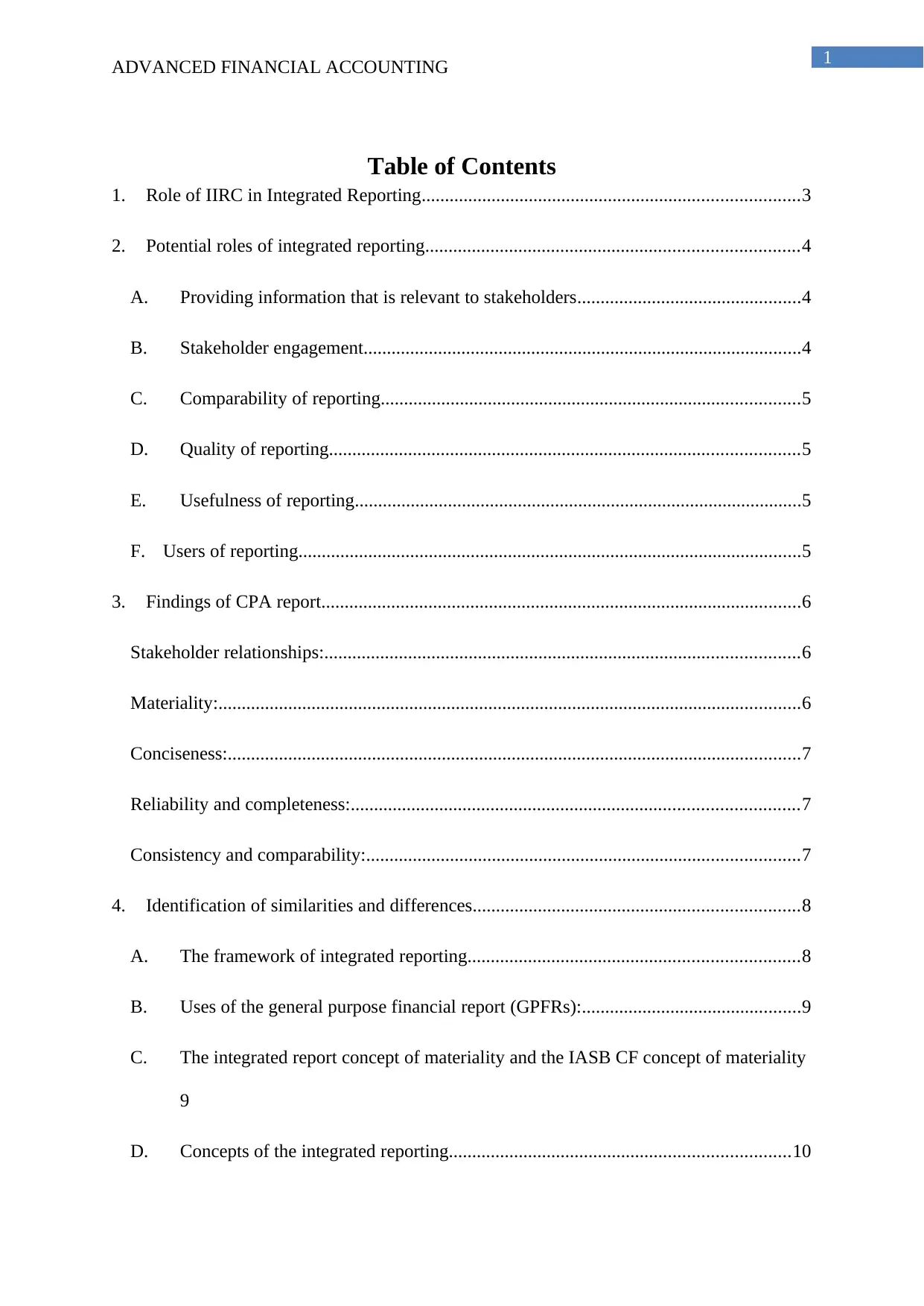
1
ADVANCED FINANCIAL ACCOUNTING
Table of Contents
1. Role of IIRC in Integrated Reporting.................................................................................3
2. Potential roles of integrated reporting................................................................................4
A. Providing information that is relevant to stakeholders................................................4
B. Stakeholder engagement..............................................................................................4
C. Comparability of reporting..........................................................................................5
D. Quality of reporting.....................................................................................................5
E. Usefulness of reporting................................................................................................5
F. Users of reporting............................................................................................................5
3. Findings of CPA report.......................................................................................................6
Stakeholder relationships:......................................................................................................6
Materiality:.............................................................................................................................6
Conciseness:...........................................................................................................................7
Reliability and completeness:................................................................................................7
Consistency and comparability:.............................................................................................7
4. Identification of similarities and differences......................................................................8
A. The framework of integrated reporting.......................................................................8
B. Uses of the general purpose financial report (GPFRs):...............................................9
C. The integrated report concept of materiality and the IASB CF concept of materiality
9
D. Concepts of the integrated reporting.........................................................................10
ADVANCED FINANCIAL ACCOUNTING
Table of Contents
1. Role of IIRC in Integrated Reporting.................................................................................3
2. Potential roles of integrated reporting................................................................................4
A. Providing information that is relevant to stakeholders................................................4
B. Stakeholder engagement..............................................................................................4
C. Comparability of reporting..........................................................................................5
D. Quality of reporting.....................................................................................................5
E. Usefulness of reporting................................................................................................5
F. Users of reporting............................................................................................................5
3. Findings of CPA report.......................................................................................................6
Stakeholder relationships:......................................................................................................6
Materiality:.............................................................................................................................6
Conciseness:...........................................................................................................................7
Reliability and completeness:................................................................................................7
Consistency and comparability:.............................................................................................7
4. Identification of similarities and differences......................................................................8
A. The framework of integrated reporting.......................................................................8
B. Uses of the general purpose financial report (GPFRs):...............................................9
C. The integrated report concept of materiality and the IASB CF concept of materiality
9
D. Concepts of the integrated reporting.........................................................................10
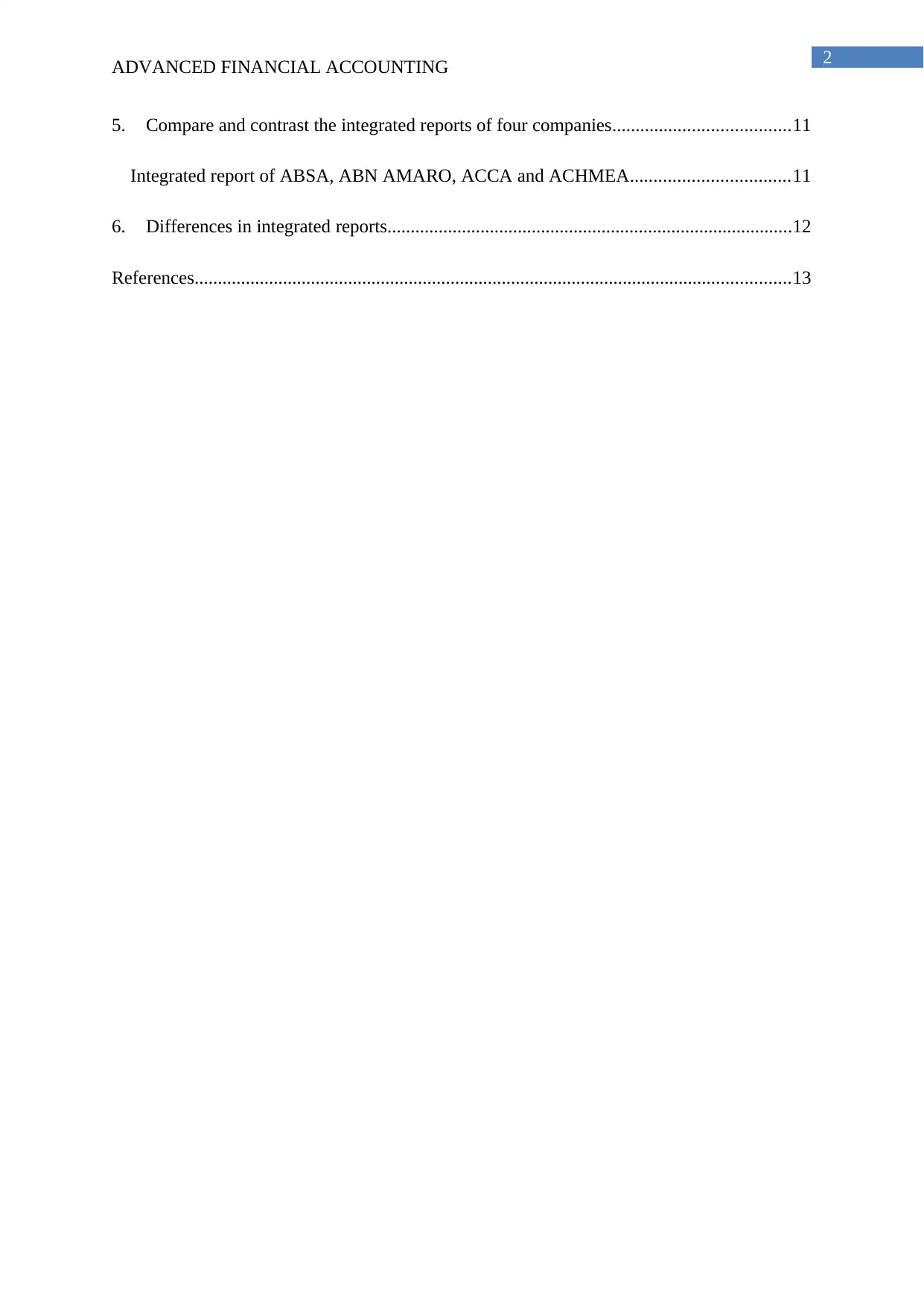
2
ADVANCED FINANCIAL ACCOUNTING
5. Compare and contrast the integrated reports of four companies......................................11
Integrated report of ABSA, ABN AMARO, ACCA and ACHMEA..................................11
6. Differences in integrated reports.......................................................................................12
References................................................................................................................................13
ADVANCED FINANCIAL ACCOUNTING
5. Compare and contrast the integrated reports of four companies......................................11
Integrated report of ABSA, ABN AMARO, ACCA and ACHMEA..................................11
6. Differences in integrated reports.......................................................................................12
References................................................................................................................................13
⊘ This is a preview!⊘
Do you want full access?
Subscribe today to unlock all pages.

Trusted by 1+ million students worldwide
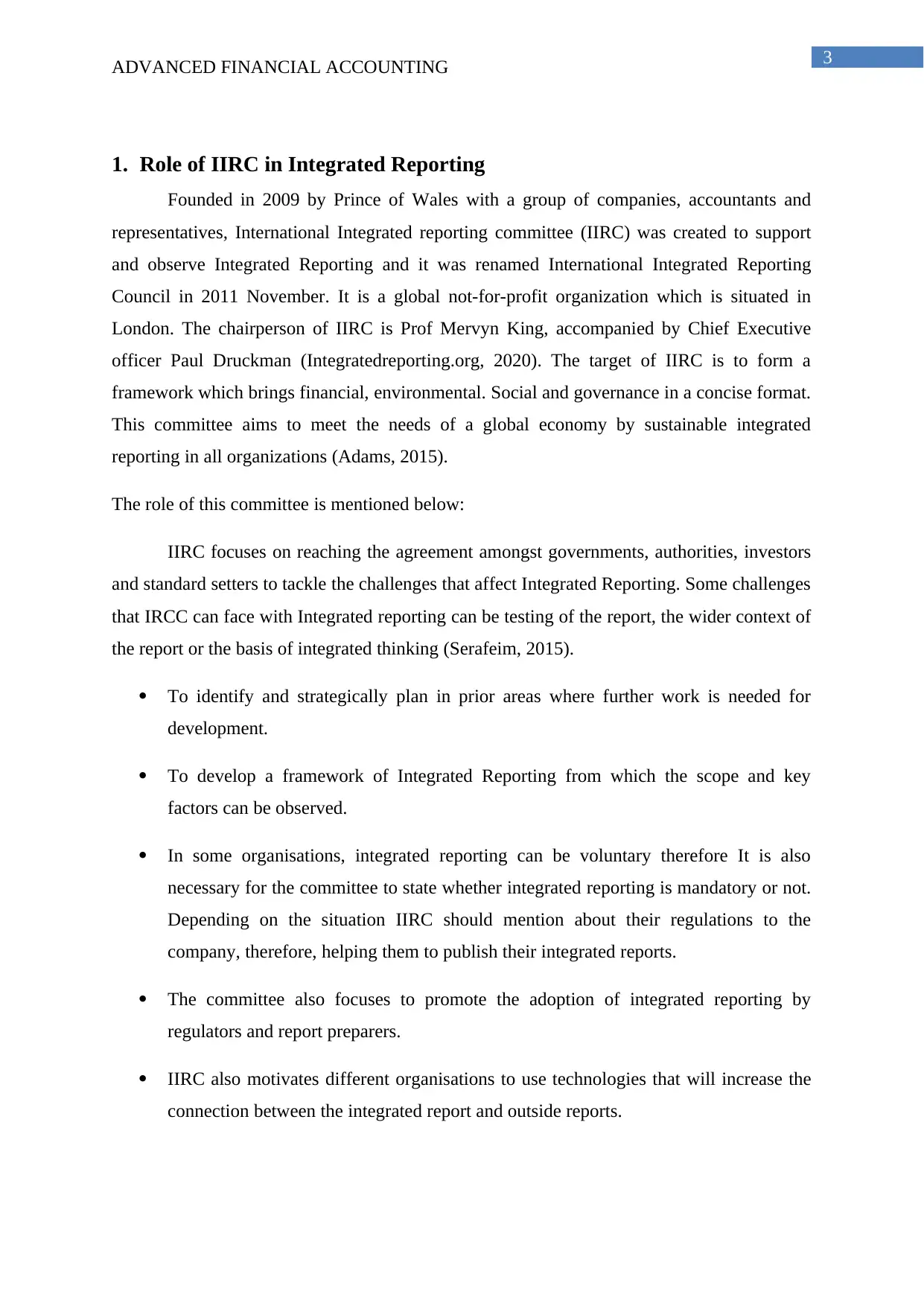
3
ADVANCED FINANCIAL ACCOUNTING
1. Role of IIRC in Integrated Reporting
Founded in 2009 by Prince of Wales with a group of companies, accountants and
representatives, International Integrated reporting committee (IIRC) was created to support
and observe Integrated Reporting and it was renamed International Integrated Reporting
Council in 2011 November. It is a global not-for-profit organization which is situated in
London. The chairperson of IIRC is Prof Mervyn King, accompanied by Chief Executive
officer Paul Druckman (Integratedreporting.org, 2020). The target of IIRC is to form a
framework which brings financial, environmental. Social and governance in a concise format.
This committee aims to meet the needs of a global economy by sustainable integrated
reporting in all organizations (Adams, 2015).
The role of this committee is mentioned below:
IIRC focuses on reaching the agreement amongst governments, authorities, investors
and standard setters to tackle the challenges that affect Integrated Reporting. Some challenges
that IRCC can face with Integrated reporting can be testing of the report, the wider context of
the report or the basis of integrated thinking (Serafeim, 2015).
To identify and strategically plan in prior areas where further work is needed for
development.
To develop a framework of Integrated Reporting from which the scope and key
factors can be observed.
In some organisations, integrated reporting can be voluntary therefore It is also
necessary for the committee to state whether integrated reporting is mandatory or not.
Depending on the situation IIRC should mention about their regulations to the
company, therefore, helping them to publish their integrated reports.
The committee also focuses to promote the adoption of integrated reporting by
regulators and report preparers.
IIRC also motivates different organisations to use technologies that will increase the
connection between the integrated report and outside reports.
ADVANCED FINANCIAL ACCOUNTING
1. Role of IIRC in Integrated Reporting
Founded in 2009 by Prince of Wales with a group of companies, accountants and
representatives, International Integrated reporting committee (IIRC) was created to support
and observe Integrated Reporting and it was renamed International Integrated Reporting
Council in 2011 November. It is a global not-for-profit organization which is situated in
London. The chairperson of IIRC is Prof Mervyn King, accompanied by Chief Executive
officer Paul Druckman (Integratedreporting.org, 2020). The target of IIRC is to form a
framework which brings financial, environmental. Social and governance in a concise format.
This committee aims to meet the needs of a global economy by sustainable integrated
reporting in all organizations (Adams, 2015).
The role of this committee is mentioned below:
IIRC focuses on reaching the agreement amongst governments, authorities, investors
and standard setters to tackle the challenges that affect Integrated Reporting. Some challenges
that IRCC can face with Integrated reporting can be testing of the report, the wider context of
the report or the basis of integrated thinking (Serafeim, 2015).
To identify and strategically plan in prior areas where further work is needed for
development.
To develop a framework of Integrated Reporting from which the scope and key
factors can be observed.
In some organisations, integrated reporting can be voluntary therefore It is also
necessary for the committee to state whether integrated reporting is mandatory or not.
Depending on the situation IIRC should mention about their regulations to the
company, therefore, helping them to publish their integrated reports.
The committee also focuses to promote the adoption of integrated reporting by
regulators and report preparers.
IIRC also motivates different organisations to use technologies that will increase the
connection between the integrated report and outside reports.
Paraphrase This Document
Need a fresh take? Get an instant paraphrase of this document with our AI Paraphraser
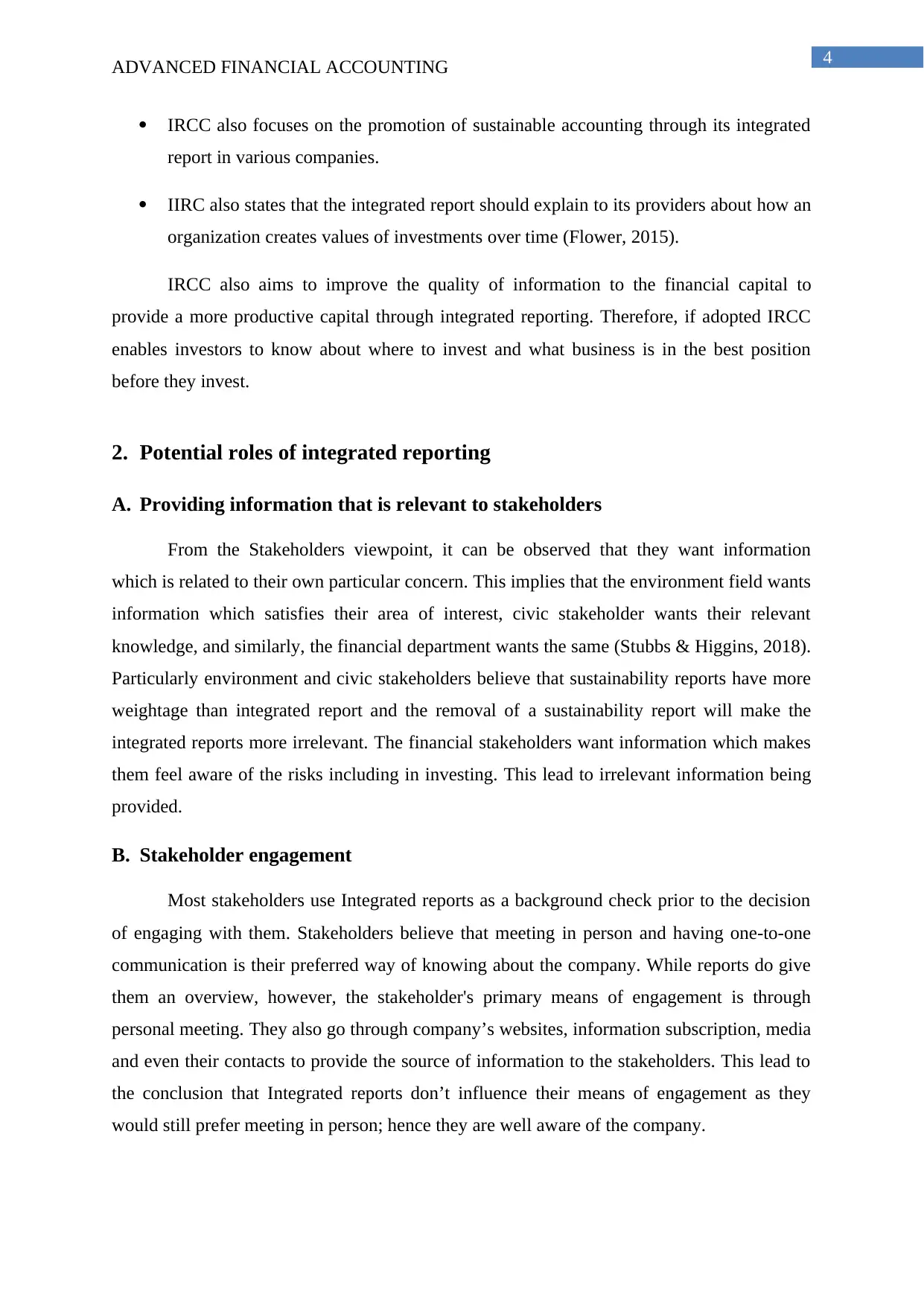
4
ADVANCED FINANCIAL ACCOUNTING
IRCC also focuses on the promotion of sustainable accounting through its integrated
report in various companies.
IIRC also states that the integrated report should explain to its providers about how an
organization creates values of investments over time (Flower, 2015).
IRCC also aims to improve the quality of information to the financial capital to
provide a more productive capital through integrated reporting. Therefore, if adopted IRCC
enables investors to know about where to invest and what business is in the best position
before they invest.
2. Potential roles of integrated reporting
A. Providing information that is relevant to stakeholders
From the Stakeholders viewpoint, it can be observed that they want information
which is related to their own particular concern. This implies that the environment field wants
information which satisfies their area of interest, civic stakeholder wants their relevant
knowledge, and similarly, the financial department wants the same (Stubbs & Higgins, 2018).
Particularly environment and civic stakeholders believe that sustainability reports have more
weightage than integrated report and the removal of a sustainability report will make the
integrated reports more irrelevant. The financial stakeholders want information which makes
them feel aware of the risks including in investing. This lead to irrelevant information being
provided.
B. Stakeholder engagement
Most stakeholders use Integrated reports as a background check prior to the decision
of engaging with them. Stakeholders believe that meeting in person and having one-to-one
communication is their preferred way of knowing about the company. While reports do give
them an overview, however, the stakeholder's primary means of engagement is through
personal meeting. They also go through company’s websites, information subscription, media
and even their contacts to provide the source of information to the stakeholders. This lead to
the conclusion that Integrated reports don’t influence their means of engagement as they
would still prefer meeting in person; hence they are well aware of the company.
ADVANCED FINANCIAL ACCOUNTING
IRCC also focuses on the promotion of sustainable accounting through its integrated
report in various companies.
IIRC also states that the integrated report should explain to its providers about how an
organization creates values of investments over time (Flower, 2015).
IRCC also aims to improve the quality of information to the financial capital to
provide a more productive capital through integrated reporting. Therefore, if adopted IRCC
enables investors to know about where to invest and what business is in the best position
before they invest.
2. Potential roles of integrated reporting
A. Providing information that is relevant to stakeholders
From the Stakeholders viewpoint, it can be observed that they want information
which is related to their own particular concern. This implies that the environment field wants
information which satisfies their area of interest, civic stakeholder wants their relevant
knowledge, and similarly, the financial department wants the same (Stubbs & Higgins, 2018).
Particularly environment and civic stakeholders believe that sustainability reports have more
weightage than integrated report and the removal of a sustainability report will make the
integrated reports more irrelevant. The financial stakeholders want information which makes
them feel aware of the risks including in investing. This lead to irrelevant information being
provided.
B. Stakeholder engagement
Most stakeholders use Integrated reports as a background check prior to the decision
of engaging with them. Stakeholders believe that meeting in person and having one-to-one
communication is their preferred way of knowing about the company. While reports do give
them an overview, however, the stakeholder's primary means of engagement is through
personal meeting. They also go through company’s websites, information subscription, media
and even their contacts to provide the source of information to the stakeholders. This lead to
the conclusion that Integrated reports don’t influence their means of engagement as they
would still prefer meeting in person; hence they are well aware of the company.
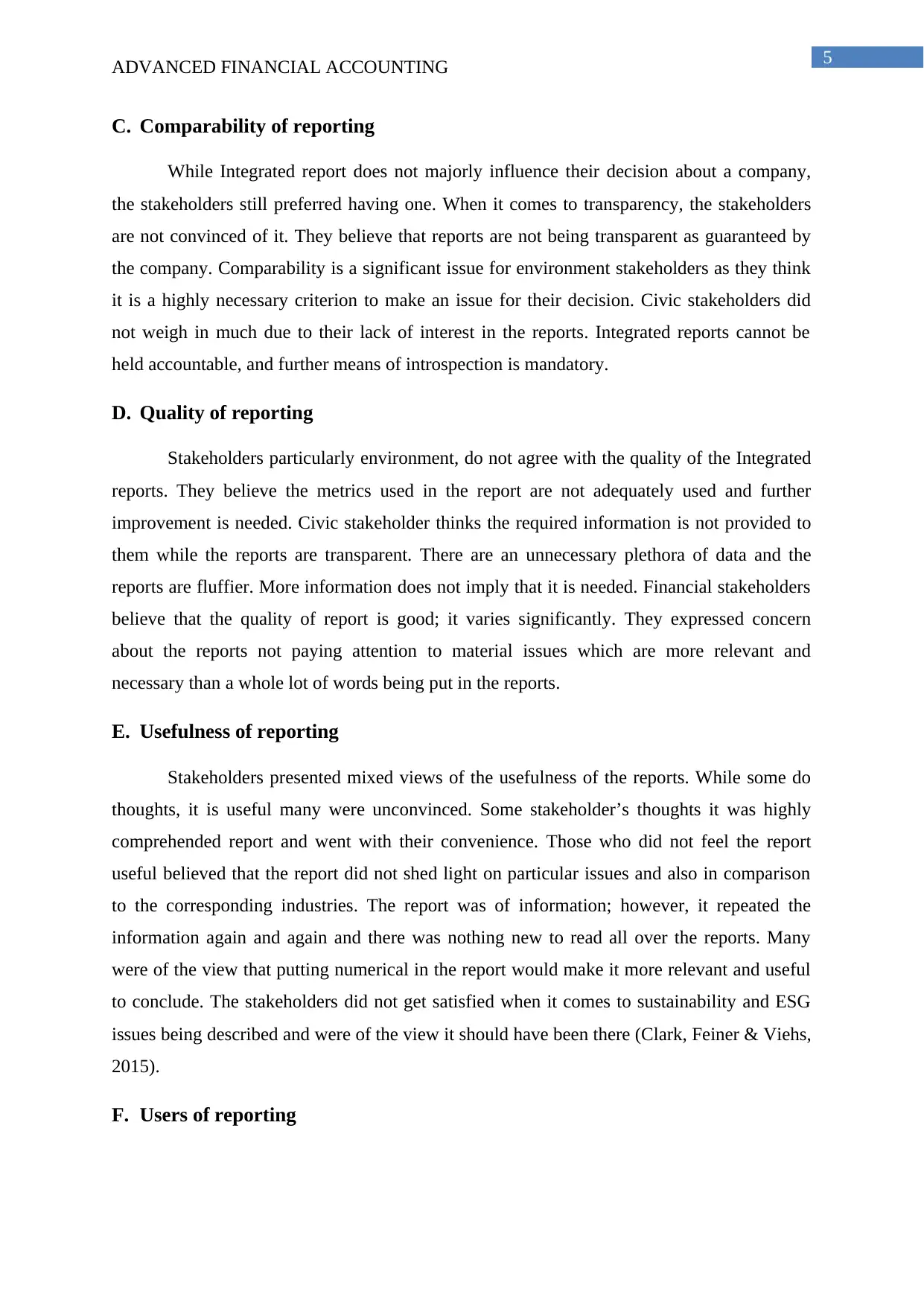
5
ADVANCED FINANCIAL ACCOUNTING
C. Comparability of reporting
While Integrated report does not majorly influence their decision about a company,
the stakeholders still preferred having one. When it comes to transparency, the stakeholders
are not convinced of it. They believe that reports are not being transparent as guaranteed by
the company. Comparability is a significant issue for environment stakeholders as they think
it is a highly necessary criterion to make an issue for their decision. Civic stakeholders did
not weigh in much due to their lack of interest in the reports. Integrated reports cannot be
held accountable, and further means of introspection is mandatory.
D. Quality of reporting
Stakeholders particularly environment, do not agree with the quality of the Integrated
reports. They believe the metrics used in the report are not adequately used and further
improvement is needed. Civic stakeholder thinks the required information is not provided to
them while the reports are transparent. There are an unnecessary plethora of data and the
reports are fluffier. More information does not imply that it is needed. Financial stakeholders
believe that the quality of report is good; it varies significantly. They expressed concern
about the reports not paying attention to material issues which are more relevant and
necessary than a whole lot of words being put in the reports.
E. Usefulness of reporting
Stakeholders presented mixed views of the usefulness of the reports. While some do
thoughts, it is useful many were unconvinced. Some stakeholder’s thoughts it was highly
comprehended report and went with their convenience. Those who did not feel the report
useful believed that the report did not shed light on particular issues and also in comparison
to the corresponding industries. The report was of information; however, it repeated the
information again and again and there was nothing new to read all over the reports. Many
were of the view that putting numerical in the report would make it more relevant and useful
to conclude. The stakeholders did not get satisfied when it comes to sustainability and ESG
issues being described and were of the view it should have been there (Clark, Feiner & Viehs,
2015).
F. Users of reporting
ADVANCED FINANCIAL ACCOUNTING
C. Comparability of reporting
While Integrated report does not majorly influence their decision about a company,
the stakeholders still preferred having one. When it comes to transparency, the stakeholders
are not convinced of it. They believe that reports are not being transparent as guaranteed by
the company. Comparability is a significant issue for environment stakeholders as they think
it is a highly necessary criterion to make an issue for their decision. Civic stakeholders did
not weigh in much due to their lack of interest in the reports. Integrated reports cannot be
held accountable, and further means of introspection is mandatory.
D. Quality of reporting
Stakeholders particularly environment, do not agree with the quality of the Integrated
reports. They believe the metrics used in the report are not adequately used and further
improvement is needed. Civic stakeholder thinks the required information is not provided to
them while the reports are transparent. There are an unnecessary plethora of data and the
reports are fluffier. More information does not imply that it is needed. Financial stakeholders
believe that the quality of report is good; it varies significantly. They expressed concern
about the reports not paying attention to material issues which are more relevant and
necessary than a whole lot of words being put in the reports.
E. Usefulness of reporting
Stakeholders presented mixed views of the usefulness of the reports. While some do
thoughts, it is useful many were unconvinced. Some stakeholder’s thoughts it was highly
comprehended report and went with their convenience. Those who did not feel the report
useful believed that the report did not shed light on particular issues and also in comparison
to the corresponding industries. The report was of information; however, it repeated the
information again and again and there was nothing new to read all over the reports. Many
were of the view that putting numerical in the report would make it more relevant and useful
to conclude. The stakeholders did not get satisfied when it comes to sustainability and ESG
issues being described and were of the view it should have been there (Clark, Feiner & Viehs,
2015).
F. Users of reporting
⊘ This is a preview!⊘
Do you want full access?
Subscribe today to unlock all pages.

Trusted by 1+ million students worldwide
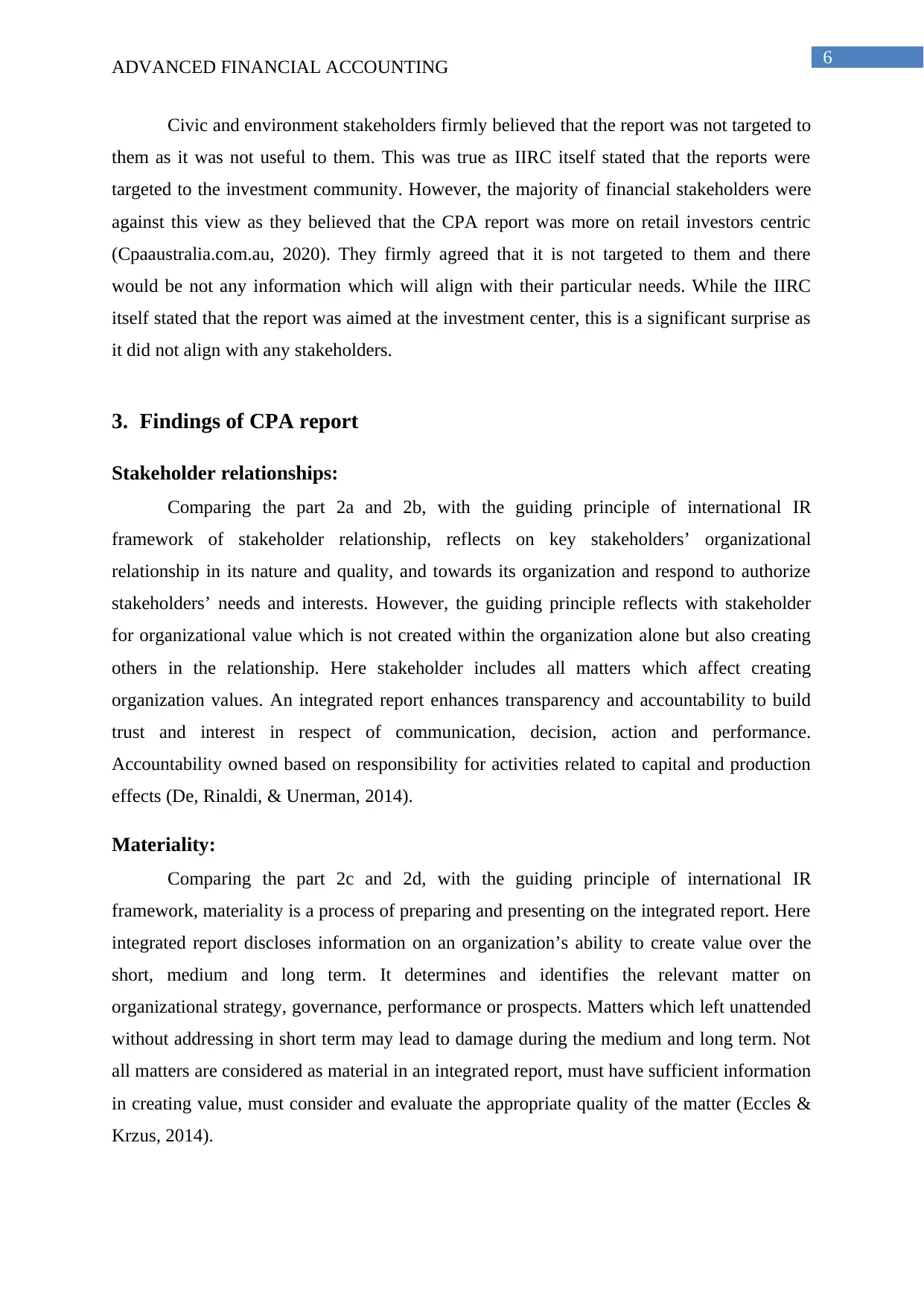
6
ADVANCED FINANCIAL ACCOUNTING
Civic and environment stakeholders firmly believed that the report was not targeted to
them as it was not useful to them. This was true as IIRC itself stated that the reports were
targeted to the investment community. However, the majority of financial stakeholders were
against this view as they believed that the CPA report was more on retail investors centric
(Cpaaustralia.com.au, 2020). They firmly agreed that it is not targeted to them and there
would be not any information which will align with their particular needs. While the IIRC
itself stated that the report was aimed at the investment center, this is a significant surprise as
it did not align with any stakeholders.
3. Findings of CPA report
Stakeholder relationships:
Comparing the part 2a and 2b, with the guiding principle of international IR
framework of stakeholder relationship, reflects on key stakeholders’ organizational
relationship in its nature and quality, and towards its organization and respond to authorize
stakeholders’ needs and interests. However, the guiding principle reflects with stakeholder
for organizational value which is not created within the organization alone but also creating
others in the relationship. Here stakeholder includes all matters which affect creating
organization values. An integrated report enhances transparency and accountability to build
trust and interest in respect of communication, decision, action and performance.
Accountability owned based on responsibility for activities related to capital and production
effects (De, Rinaldi, & Unerman, 2014).
Materiality:
Comparing the part 2c and 2d, with the guiding principle of international IR
framework, materiality is a process of preparing and presenting on the integrated report. Here
integrated report discloses information on an organization’s ability to create value over the
short, medium and long term. It determines and identifies the relevant matter on
organizational strategy, governance, performance or prospects. Matters which left unattended
without addressing in short term may lead to damage during the medium and long term. Not
all matters are considered as material in an integrated report, must have sufficient information
in creating value, must consider and evaluate the appropriate quality of the matter (Eccles &
Krzus, 2014).
ADVANCED FINANCIAL ACCOUNTING
Civic and environment stakeholders firmly believed that the report was not targeted to
them as it was not useful to them. This was true as IIRC itself stated that the reports were
targeted to the investment community. However, the majority of financial stakeholders were
against this view as they believed that the CPA report was more on retail investors centric
(Cpaaustralia.com.au, 2020). They firmly agreed that it is not targeted to them and there
would be not any information which will align with their particular needs. While the IIRC
itself stated that the report was aimed at the investment center, this is a significant surprise as
it did not align with any stakeholders.
3. Findings of CPA report
Stakeholder relationships:
Comparing the part 2a and 2b, with the guiding principle of international IR
framework of stakeholder relationship, reflects on key stakeholders’ organizational
relationship in its nature and quality, and towards its organization and respond to authorize
stakeholders’ needs and interests. However, the guiding principle reflects with stakeholder
for organizational value which is not created within the organization alone but also creating
others in the relationship. Here stakeholder includes all matters which affect creating
organization values. An integrated report enhances transparency and accountability to build
trust and interest in respect of communication, decision, action and performance.
Accountability owned based on responsibility for activities related to capital and production
effects (De, Rinaldi, & Unerman, 2014).
Materiality:
Comparing the part 2c and 2d, with the guiding principle of international IR
framework, materiality is a process of preparing and presenting on the integrated report. Here
integrated report discloses information on an organization’s ability to create value over the
short, medium and long term. It determines and identifies the relevant matter on
organizational strategy, governance, performance or prospects. Matters which left unattended
without addressing in short term may lead to damage during the medium and long term. Not
all matters are considered as material in an integrated report, must have sufficient information
in creating value, must consider and evaluate the appropriate quality of the matter (Eccles &
Krzus, 2014).
Paraphrase This Document
Need a fresh take? Get an instant paraphrase of this document with our AI Paraphraser
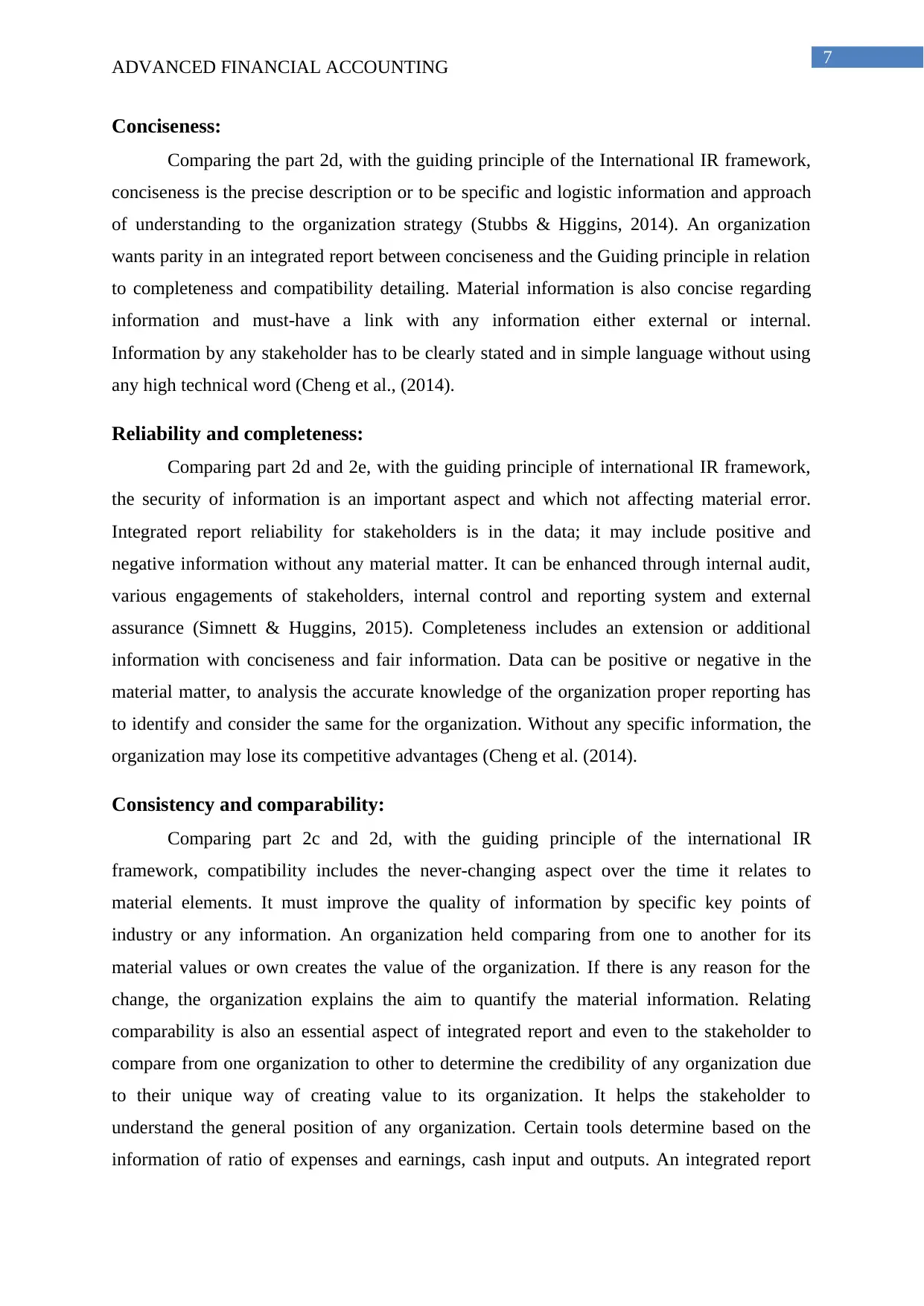
7
ADVANCED FINANCIAL ACCOUNTING
Conciseness:
Comparing the part 2d, with the guiding principle of the International IR framework,
conciseness is the precise description or to be specific and logistic information and approach
of understanding to the organization strategy (Stubbs & Higgins, 2014). An organization
wants parity in an integrated report between conciseness and the Guiding principle in relation
to completeness and compatibility detailing. Material information is also concise regarding
information and must-have a link with any information either external or internal.
Information by any stakeholder has to be clearly stated and in simple language without using
any high technical word (Cheng et al., (2014).
Reliability and completeness:
Comparing part 2d and 2e, with the guiding principle of international IR framework,
the security of information is an important aspect and which not affecting material error.
Integrated report reliability for stakeholders is in the data; it may include positive and
negative information without any material matter. It can be enhanced through internal audit,
various engagements of stakeholders, internal control and reporting system and external
assurance (Simnett & Huggins, 2015). Completeness includes an extension or additional
information with conciseness and fair information. Data can be positive or negative in the
material matter, to analysis the accurate knowledge of the organization proper reporting has
to identify and consider the same for the organization. Without any specific information, the
organization may lose its competitive advantages (Cheng et al. (2014).
Consistency and comparability:
Comparing part 2c and 2d, with the guiding principle of the international IR
framework, compatibility includes the never-changing aspect over the time it relates to
material elements. It must improve the quality of information by specific key points of
industry or any information. An organization held comparing from one to another for its
material values or own creates the value of the organization. If there is any reason for the
change, the organization explains the aim to quantify the material information. Relating
comparability is also an essential aspect of integrated report and even to the stakeholder to
compare from one organization to other to determine the credibility of any organization due
to their unique way of creating value to its organization. It helps the stakeholder to
understand the general position of any organization. Certain tools determine based on the
information of ratio of expenses and earnings, cash input and outputs. An integrated report
ADVANCED FINANCIAL ACCOUNTING
Conciseness:
Comparing the part 2d, with the guiding principle of the International IR framework,
conciseness is the precise description or to be specific and logistic information and approach
of understanding to the organization strategy (Stubbs & Higgins, 2014). An organization
wants parity in an integrated report between conciseness and the Guiding principle in relation
to completeness and compatibility detailing. Material information is also concise regarding
information and must-have a link with any information either external or internal.
Information by any stakeholder has to be clearly stated and in simple language without using
any high technical word (Cheng et al., (2014).
Reliability and completeness:
Comparing part 2d and 2e, with the guiding principle of international IR framework,
the security of information is an important aspect and which not affecting material error.
Integrated report reliability for stakeholders is in the data; it may include positive and
negative information without any material matter. It can be enhanced through internal audit,
various engagements of stakeholders, internal control and reporting system and external
assurance (Simnett & Huggins, 2015). Completeness includes an extension or additional
information with conciseness and fair information. Data can be positive or negative in the
material matter, to analysis the accurate knowledge of the organization proper reporting has
to identify and consider the same for the organization. Without any specific information, the
organization may lose its competitive advantages (Cheng et al. (2014).
Consistency and comparability:
Comparing part 2c and 2d, with the guiding principle of the international IR
framework, compatibility includes the never-changing aspect over the time it relates to
material elements. It must improve the quality of information by specific key points of
industry or any information. An organization held comparing from one to another for its
material values or own creates the value of the organization. If there is any reason for the
change, the organization explains the aim to quantify the material information. Relating
comparability is also an essential aspect of integrated report and even to the stakeholder to
compare from one organization to other to determine the credibility of any organization due
to their unique way of creating value to its organization. It helps the stakeholder to
understand the general position of any organization. Certain tools determine based on the
information of ratio of expenses and earnings, cash input and outputs. An integrated report
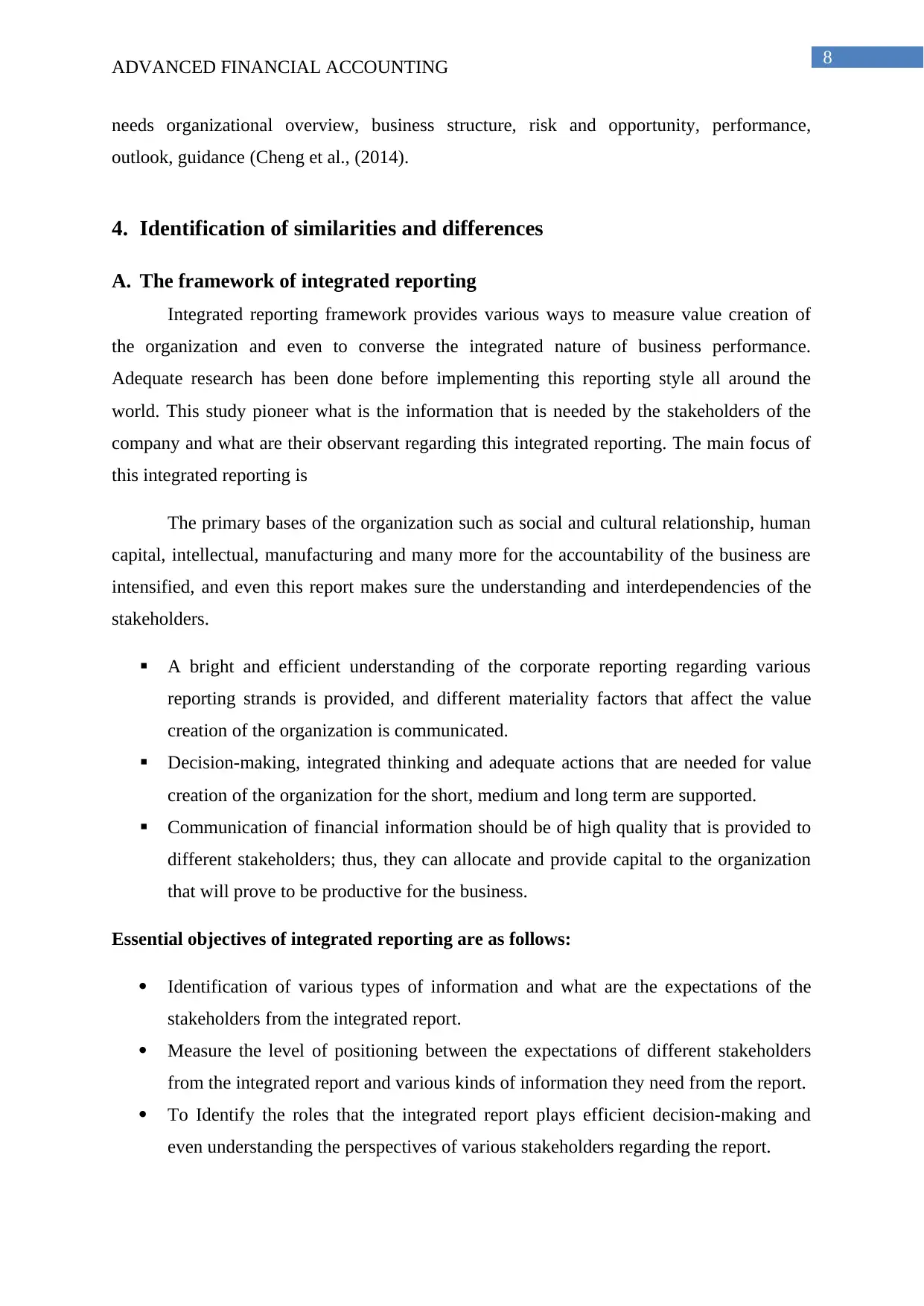
8
ADVANCED FINANCIAL ACCOUNTING
needs organizational overview, business structure, risk and opportunity, performance,
outlook, guidance (Cheng et al., (2014).
4. Identification of similarities and differences
A. The framework of integrated reporting
Integrated reporting framework provides various ways to measure value creation of
the organization and even to converse the integrated nature of business performance.
Adequate research has been done before implementing this reporting style all around the
world. This study pioneer what is the information that is needed by the stakeholders of the
company and what are their observant regarding this integrated reporting. The main focus of
this integrated reporting is
The primary bases of the organization such as social and cultural relationship, human
capital, intellectual, manufacturing and many more for the accountability of the business are
intensified, and even this report makes sure the understanding and interdependencies of the
stakeholders.
A bright and efficient understanding of the corporate reporting regarding various
reporting strands is provided, and different materiality factors that affect the value
creation of the organization is communicated.
Decision-making, integrated thinking and adequate actions that are needed for value
creation of the organization for the short, medium and long term are supported.
Communication of financial information should be of high quality that is provided to
different stakeholders; thus, they can allocate and provide capital to the organization
that will prove to be productive for the business.
Essential objectives of integrated reporting are as follows:
Identification of various types of information and what are the expectations of the
stakeholders from the integrated report.
Measure the level of positioning between the expectations of different stakeholders
from the integrated report and various kinds of information they need from the report.
To Identify the roles that the integrated report plays efficient decision-making and
even understanding the perspectives of various stakeholders regarding the report.
ADVANCED FINANCIAL ACCOUNTING
needs organizational overview, business structure, risk and opportunity, performance,
outlook, guidance (Cheng et al., (2014).
4. Identification of similarities and differences
A. The framework of integrated reporting
Integrated reporting framework provides various ways to measure value creation of
the organization and even to converse the integrated nature of business performance.
Adequate research has been done before implementing this reporting style all around the
world. This study pioneer what is the information that is needed by the stakeholders of the
company and what are their observant regarding this integrated reporting. The main focus of
this integrated reporting is
The primary bases of the organization such as social and cultural relationship, human
capital, intellectual, manufacturing and many more for the accountability of the business are
intensified, and even this report makes sure the understanding and interdependencies of the
stakeholders.
A bright and efficient understanding of the corporate reporting regarding various
reporting strands is provided, and different materiality factors that affect the value
creation of the organization is communicated.
Decision-making, integrated thinking and adequate actions that are needed for value
creation of the organization for the short, medium and long term are supported.
Communication of financial information should be of high quality that is provided to
different stakeholders; thus, they can allocate and provide capital to the organization
that will prove to be productive for the business.
Essential objectives of integrated reporting are as follows:
Identification of various types of information and what are the expectations of the
stakeholders from the integrated report.
Measure the level of positioning between the expectations of different stakeholders
from the integrated report and various kinds of information they need from the report.
To Identify the roles that the integrated report plays efficient decision-making and
even understanding the perspectives of various stakeholders regarding the report.
⊘ This is a preview!⊘
Do you want full access?
Subscribe today to unlock all pages.

Trusted by 1+ million students worldwide
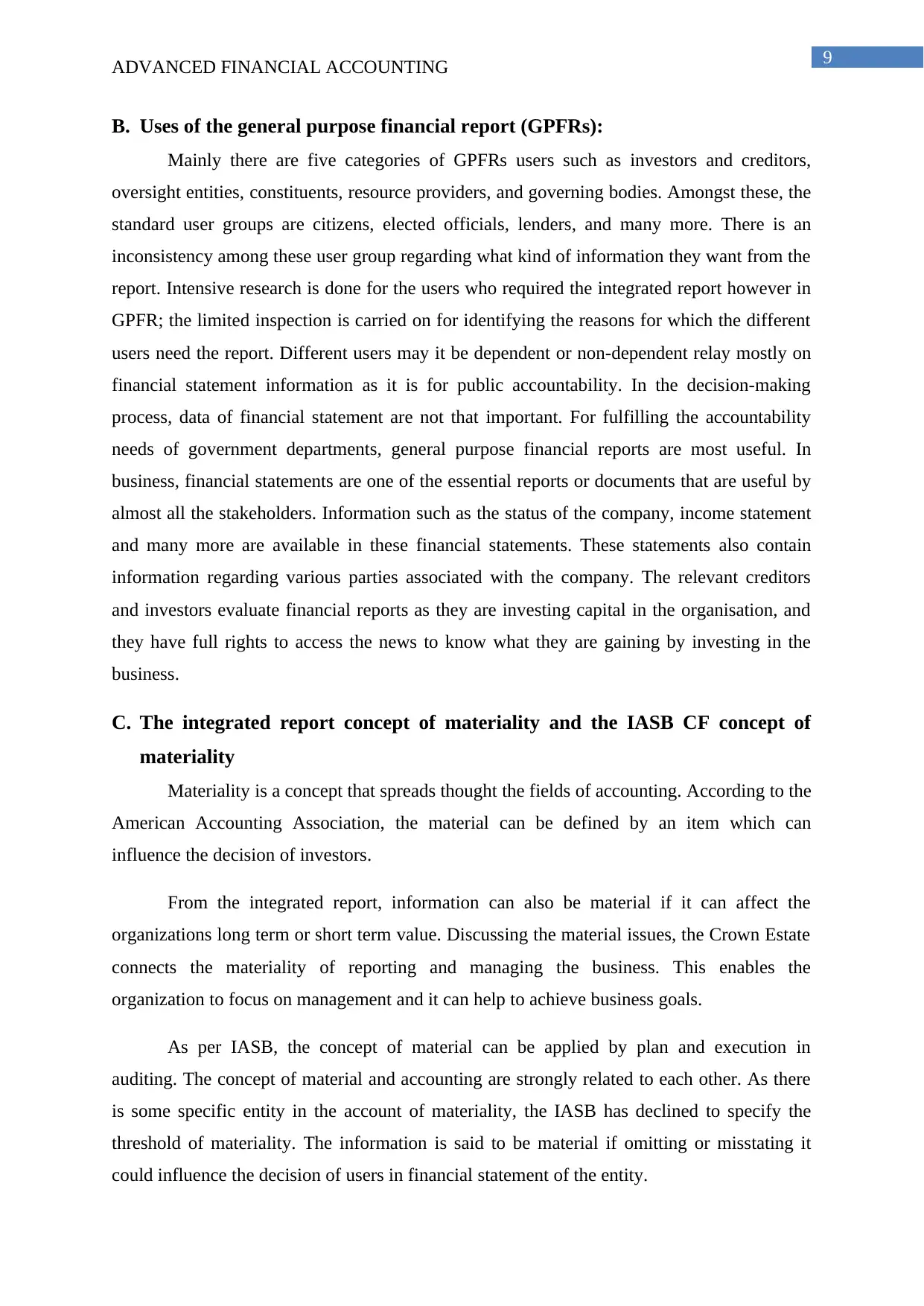
9
ADVANCED FINANCIAL ACCOUNTING
B. Uses of the general purpose financial report (GPFRs):
Mainly there are five categories of GPFRs users such as investors and creditors,
oversight entities, constituents, resource providers, and governing bodies. Amongst these, the
standard user groups are citizens, elected officials, lenders, and many more. There is an
inconsistency among these user group regarding what kind of information they want from the
report. Intensive research is done for the users who required the integrated report however in
GPFR; the limited inspection is carried on for identifying the reasons for which the different
users need the report. Different users may it be dependent or non-dependent relay mostly on
financial statement information as it is for public accountability. In the decision-making
process, data of financial statement are not that important. For fulfilling the accountability
needs of government departments, general purpose financial reports are most useful. In
business, financial statements are one of the essential reports or documents that are useful by
almost all the stakeholders. Information such as the status of the company, income statement
and many more are available in these financial statements. These statements also contain
information regarding various parties associated with the company. The relevant creditors
and investors evaluate financial reports as they are investing capital in the organisation, and
they have full rights to access the news to know what they are gaining by investing in the
business.
C. The integrated report concept of materiality and the IASB CF concept of
materiality
Materiality is a concept that spreads thought the fields of accounting. According to the
American Accounting Association, the material can be defined by an item which can
influence the decision of investors.
From the integrated report, information can also be material if it can affect the
organizations long term or short term value. Discussing the material issues, the Crown Estate
connects the materiality of reporting and managing the business. This enables the
organization to focus on management and it can help to achieve business goals.
As per IASB, the concept of material can be applied by plan and execution in
auditing. The concept of material and accounting are strongly related to each other. As there
is some specific entity in the account of materiality, the IASB has declined to specify the
threshold of materiality. The information is said to be material if omitting or misstating it
could influence the decision of users in financial statement of the entity.
ADVANCED FINANCIAL ACCOUNTING
B. Uses of the general purpose financial report (GPFRs):
Mainly there are five categories of GPFRs users such as investors and creditors,
oversight entities, constituents, resource providers, and governing bodies. Amongst these, the
standard user groups are citizens, elected officials, lenders, and many more. There is an
inconsistency among these user group regarding what kind of information they want from the
report. Intensive research is done for the users who required the integrated report however in
GPFR; the limited inspection is carried on for identifying the reasons for which the different
users need the report. Different users may it be dependent or non-dependent relay mostly on
financial statement information as it is for public accountability. In the decision-making
process, data of financial statement are not that important. For fulfilling the accountability
needs of government departments, general purpose financial reports are most useful. In
business, financial statements are one of the essential reports or documents that are useful by
almost all the stakeholders. Information such as the status of the company, income statement
and many more are available in these financial statements. These statements also contain
information regarding various parties associated with the company. The relevant creditors
and investors evaluate financial reports as they are investing capital in the organisation, and
they have full rights to access the news to know what they are gaining by investing in the
business.
C. The integrated report concept of materiality and the IASB CF concept of
materiality
Materiality is a concept that spreads thought the fields of accounting. According to the
American Accounting Association, the material can be defined by an item which can
influence the decision of investors.
From the integrated report, information can also be material if it can affect the
organizations long term or short term value. Discussing the material issues, the Crown Estate
connects the materiality of reporting and managing the business. This enables the
organization to focus on management and it can help to achieve business goals.
As per IASB, the concept of material can be applied by plan and execution in
auditing. The concept of material and accounting are strongly related to each other. As there
is some specific entity in the account of materiality, the IASB has declined to specify the
threshold of materiality. The information is said to be material if omitting or misstating it
could influence the decision of users in financial statement of the entity.
Paraphrase This Document
Need a fresh take? Get an instant paraphrase of this document with our AI Paraphraser
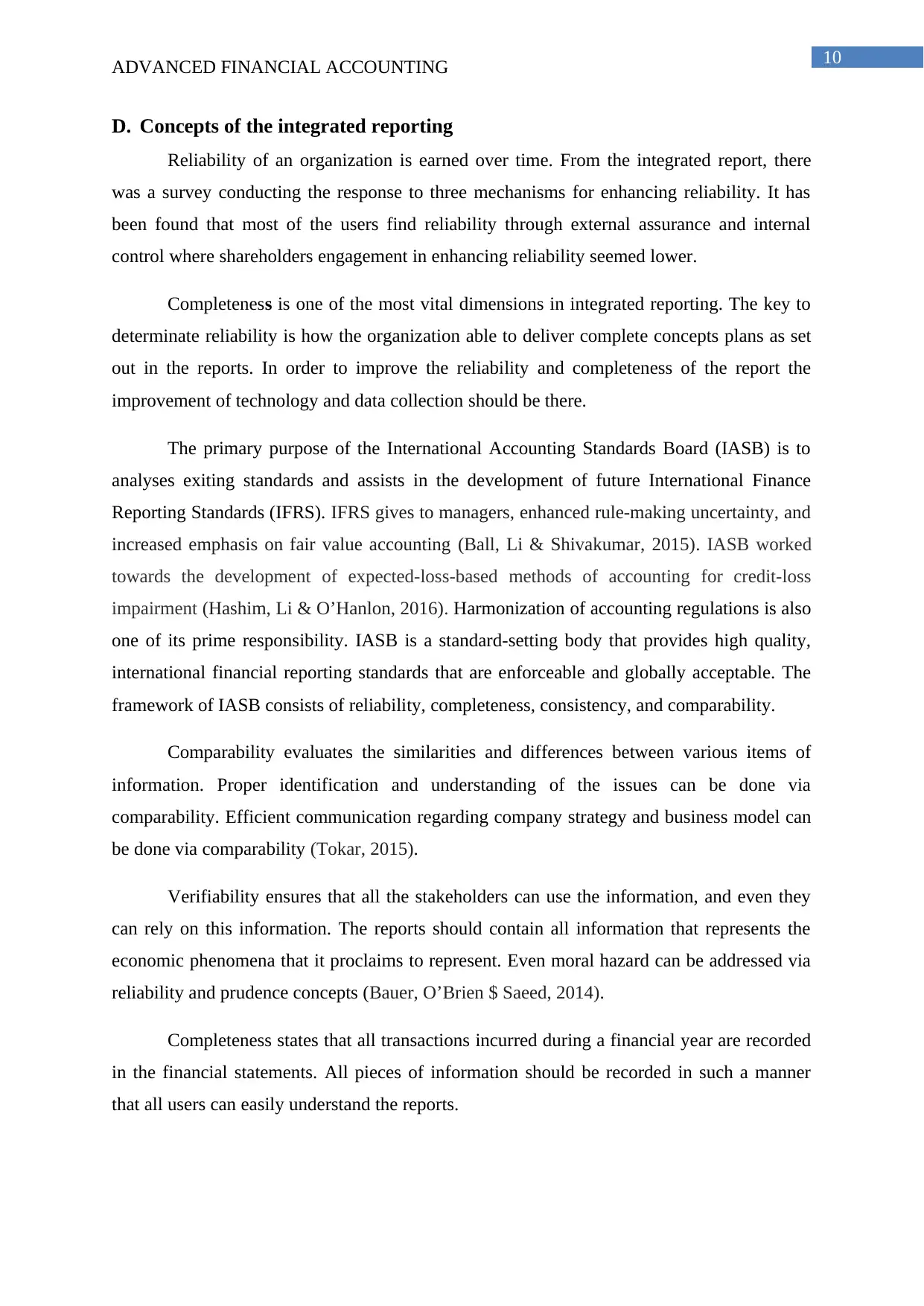
10
ADVANCED FINANCIAL ACCOUNTING
D. Concepts of the integrated reporting
Reliability of an organization is earned over time. From the integrated report, there
was a survey conducting the response to three mechanisms for enhancing reliability. It has
been found that most of the users find reliability through external assurance and internal
control where shareholders engagement in enhancing reliability seemed lower.
Completeness is one of the most vital dimensions in integrated reporting. The key to
determinate reliability is how the organization able to deliver complete concepts plans as set
out in the reports. In order to improve the reliability and completeness of the report the
improvement of technology and data collection should be there.
The primary purpose of the International Accounting Standards Board (IASB) is to
analyses exiting standards and assists in the development of future International Finance
Reporting Standards (IFRS). IFRS gives to managers, enhanced rule‐making uncertainty, and
increased emphasis on fair value accounting (Ball, Li & Shivakumar, 2015). IASB worked
towards the development of expected-loss-based methods of accounting for credit-loss
impairment (Hashim, Li & O’Hanlon, 2016). Harmonization of accounting regulations is also
one of its prime responsibility. IASB is a standard-setting body that provides high quality,
international financial reporting standards that are enforceable and globally acceptable. The
framework of IASB consists of reliability, completeness, consistency, and comparability.
Comparability evaluates the similarities and differences between various items of
information. Proper identification and understanding of the issues can be done via
comparability. Efficient communication regarding company strategy and business model can
be done via comparability (Tokar, 2015).
Verifiability ensures that all the stakeholders can use the information, and even they
can rely on this information. The reports should contain all information that represents the
economic phenomena that it proclaims to represent. Even moral hazard can be addressed via
reliability and prudence concepts (Bauer, O’Brien $ Saeed, 2014).
Completeness states that all transactions incurred during a financial year are recorded
in the financial statements. All pieces of information should be recorded in such a manner
that all users can easily understand the reports.
ADVANCED FINANCIAL ACCOUNTING
D. Concepts of the integrated reporting
Reliability of an organization is earned over time. From the integrated report, there
was a survey conducting the response to three mechanisms for enhancing reliability. It has
been found that most of the users find reliability through external assurance and internal
control where shareholders engagement in enhancing reliability seemed lower.
Completeness is one of the most vital dimensions in integrated reporting. The key to
determinate reliability is how the organization able to deliver complete concepts plans as set
out in the reports. In order to improve the reliability and completeness of the report the
improvement of technology and data collection should be there.
The primary purpose of the International Accounting Standards Board (IASB) is to
analyses exiting standards and assists in the development of future International Finance
Reporting Standards (IFRS). IFRS gives to managers, enhanced rule‐making uncertainty, and
increased emphasis on fair value accounting (Ball, Li & Shivakumar, 2015). IASB worked
towards the development of expected-loss-based methods of accounting for credit-loss
impairment (Hashim, Li & O’Hanlon, 2016). Harmonization of accounting regulations is also
one of its prime responsibility. IASB is a standard-setting body that provides high quality,
international financial reporting standards that are enforceable and globally acceptable. The
framework of IASB consists of reliability, completeness, consistency, and comparability.
Comparability evaluates the similarities and differences between various items of
information. Proper identification and understanding of the issues can be done via
comparability. Efficient communication regarding company strategy and business model can
be done via comparability (Tokar, 2015).
Verifiability ensures that all the stakeholders can use the information, and even they
can rely on this information. The reports should contain all information that represents the
economic phenomena that it proclaims to represent. Even moral hazard can be addressed via
reliability and prudence concepts (Bauer, O’Brien $ Saeed, 2014).
Completeness states that all transactions incurred during a financial year are recorded
in the financial statements. All pieces of information should be recorded in such a manner
that all users can easily understand the reports.
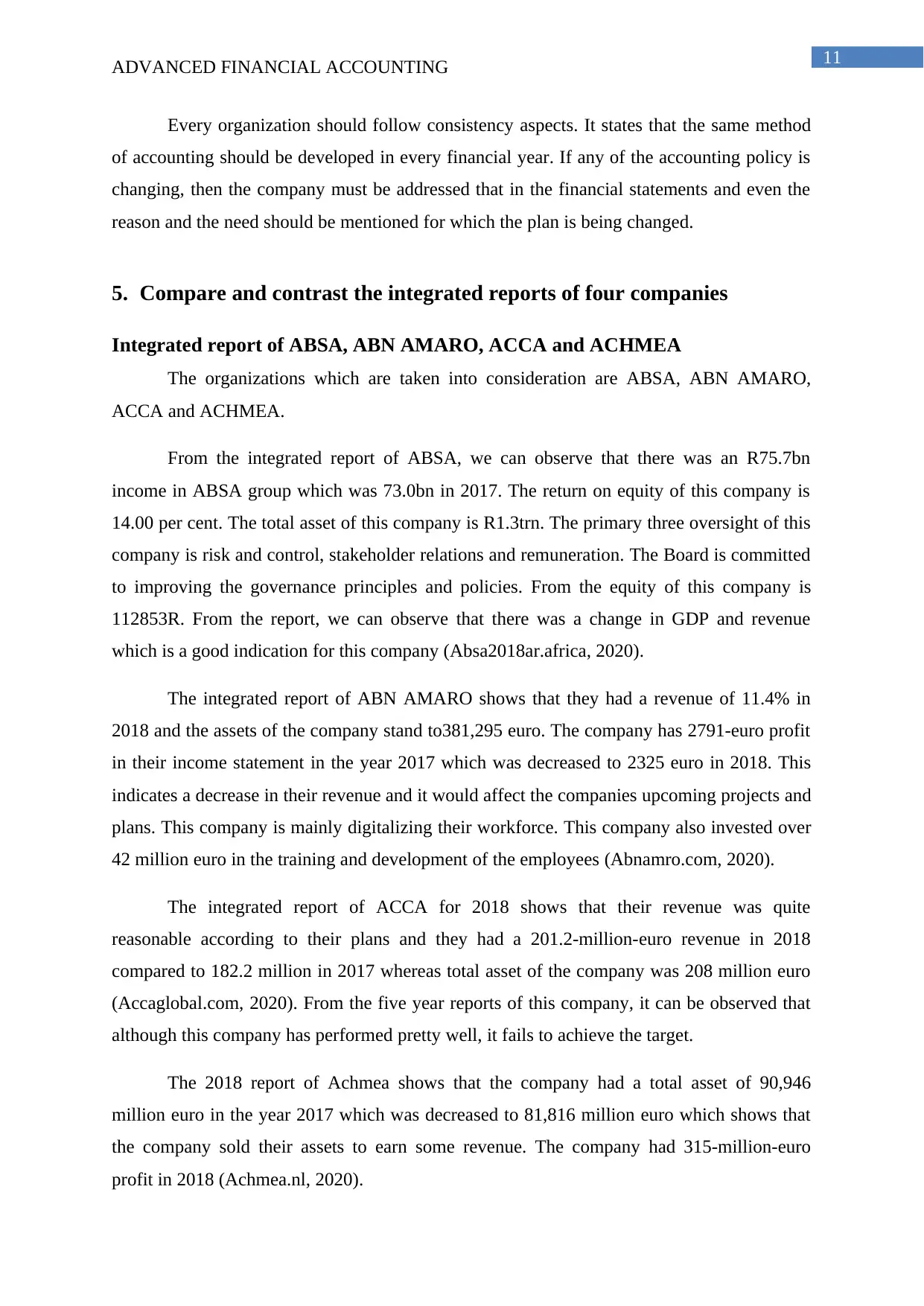
11
ADVANCED FINANCIAL ACCOUNTING
Every organization should follow consistency aspects. It states that the same method
of accounting should be developed in every financial year. If any of the accounting policy is
changing, then the company must be addressed that in the financial statements and even the
reason and the need should be mentioned for which the plan is being changed.
5. Compare and contrast the integrated reports of four companies
Integrated report of ABSA, ABN AMARO, ACCA and ACHMEA
The organizations which are taken into consideration are ABSA, ABN AMARO,
ACCA and ACHMEA.
From the integrated report of ABSA, we can observe that there was an R75.7bn
income in ABSA group which was 73.0bn in 2017. The return on equity of this company is
14.00 per cent. The total asset of this company is R1.3trn. The primary three oversight of this
company is risk and control, stakeholder relations and remuneration. The Board is committed
to improving the governance principles and policies. From the equity of this company is
112853R. From the report, we can observe that there was a change in GDP and revenue
which is a good indication for this company (Absa2018ar.africa, 2020).
The integrated report of ABN AMARO shows that they had a revenue of 11.4% in
2018 and the assets of the company stand to381,295 euro. The company has 2791-euro profit
in their income statement in the year 2017 which was decreased to 2325 euro in 2018. This
indicates a decrease in their revenue and it would affect the companies upcoming projects and
plans. This company is mainly digitalizing their workforce. This company also invested over
42 million euro in the training and development of the employees (Abnamro.com, 2020).
The integrated report of ACCA for 2018 shows that their revenue was quite
reasonable according to their plans and they had a 201.2-million-euro revenue in 2018
compared to 182.2 million in 2017 whereas total asset of the company was 208 million euro
(Accaglobal.com, 2020). From the five year reports of this company, it can be observed that
although this company has performed pretty well, it fails to achieve the target.
The 2018 report of Achmea shows that the company had a total asset of 90,946
million euro in the year 2017 which was decreased to 81,816 million euro which shows that
the company sold their assets to earn some revenue. The company had 315-million-euro
profit in 2018 (Achmea.nl, 2020).
ADVANCED FINANCIAL ACCOUNTING
Every organization should follow consistency aspects. It states that the same method
of accounting should be developed in every financial year. If any of the accounting policy is
changing, then the company must be addressed that in the financial statements and even the
reason and the need should be mentioned for which the plan is being changed.
5. Compare and contrast the integrated reports of four companies
Integrated report of ABSA, ABN AMARO, ACCA and ACHMEA
The organizations which are taken into consideration are ABSA, ABN AMARO,
ACCA and ACHMEA.
From the integrated report of ABSA, we can observe that there was an R75.7bn
income in ABSA group which was 73.0bn in 2017. The return on equity of this company is
14.00 per cent. The total asset of this company is R1.3trn. The primary three oversight of this
company is risk and control, stakeholder relations and remuneration. The Board is committed
to improving the governance principles and policies. From the equity of this company is
112853R. From the report, we can observe that there was a change in GDP and revenue
which is a good indication for this company (Absa2018ar.africa, 2020).
The integrated report of ABN AMARO shows that they had a revenue of 11.4% in
2018 and the assets of the company stand to381,295 euro. The company has 2791-euro profit
in their income statement in the year 2017 which was decreased to 2325 euro in 2018. This
indicates a decrease in their revenue and it would affect the companies upcoming projects and
plans. This company is mainly digitalizing their workforce. This company also invested over
42 million euro in the training and development of the employees (Abnamro.com, 2020).
The integrated report of ACCA for 2018 shows that their revenue was quite
reasonable according to their plans and they had a 201.2-million-euro revenue in 2018
compared to 182.2 million in 2017 whereas total asset of the company was 208 million euro
(Accaglobal.com, 2020). From the five year reports of this company, it can be observed that
although this company has performed pretty well, it fails to achieve the target.
The 2018 report of Achmea shows that the company had a total asset of 90,946
million euro in the year 2017 which was decreased to 81,816 million euro which shows that
the company sold their assets to earn some revenue. The company had 315-million-euro
profit in 2018 (Achmea.nl, 2020).
⊘ This is a preview!⊘
Do you want full access?
Subscribe today to unlock all pages.

Trusted by 1+ million students worldwide
1 out of 15
Related Documents
Your All-in-One AI-Powered Toolkit for Academic Success.
+13062052269
info@desklib.com
Available 24*7 on WhatsApp / Email
![[object Object]](/_next/static/media/star-bottom.7253800d.svg)
Unlock your academic potential
Copyright © 2020–2025 A2Z Services. All Rights Reserved. Developed and managed by ZUCOL.




